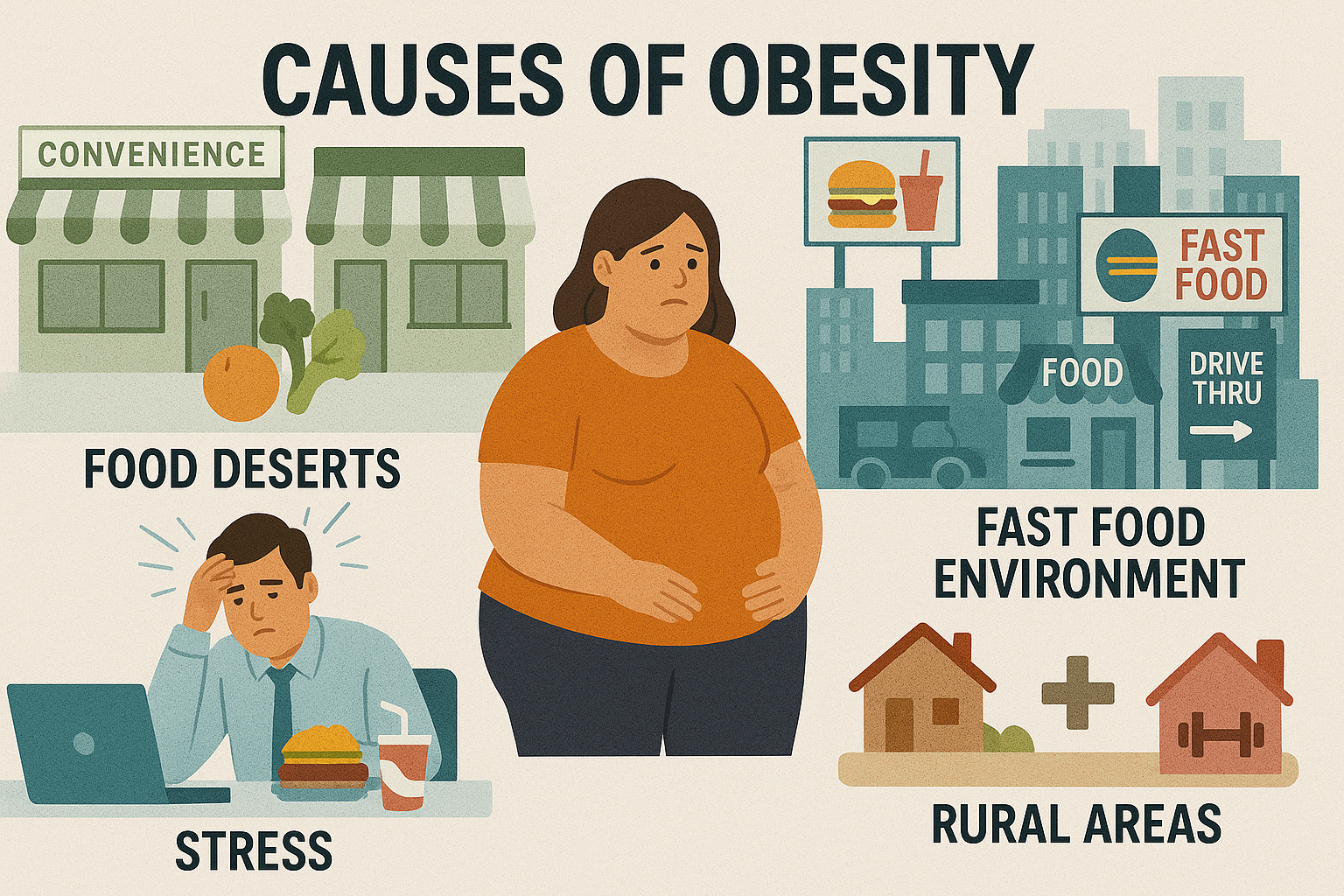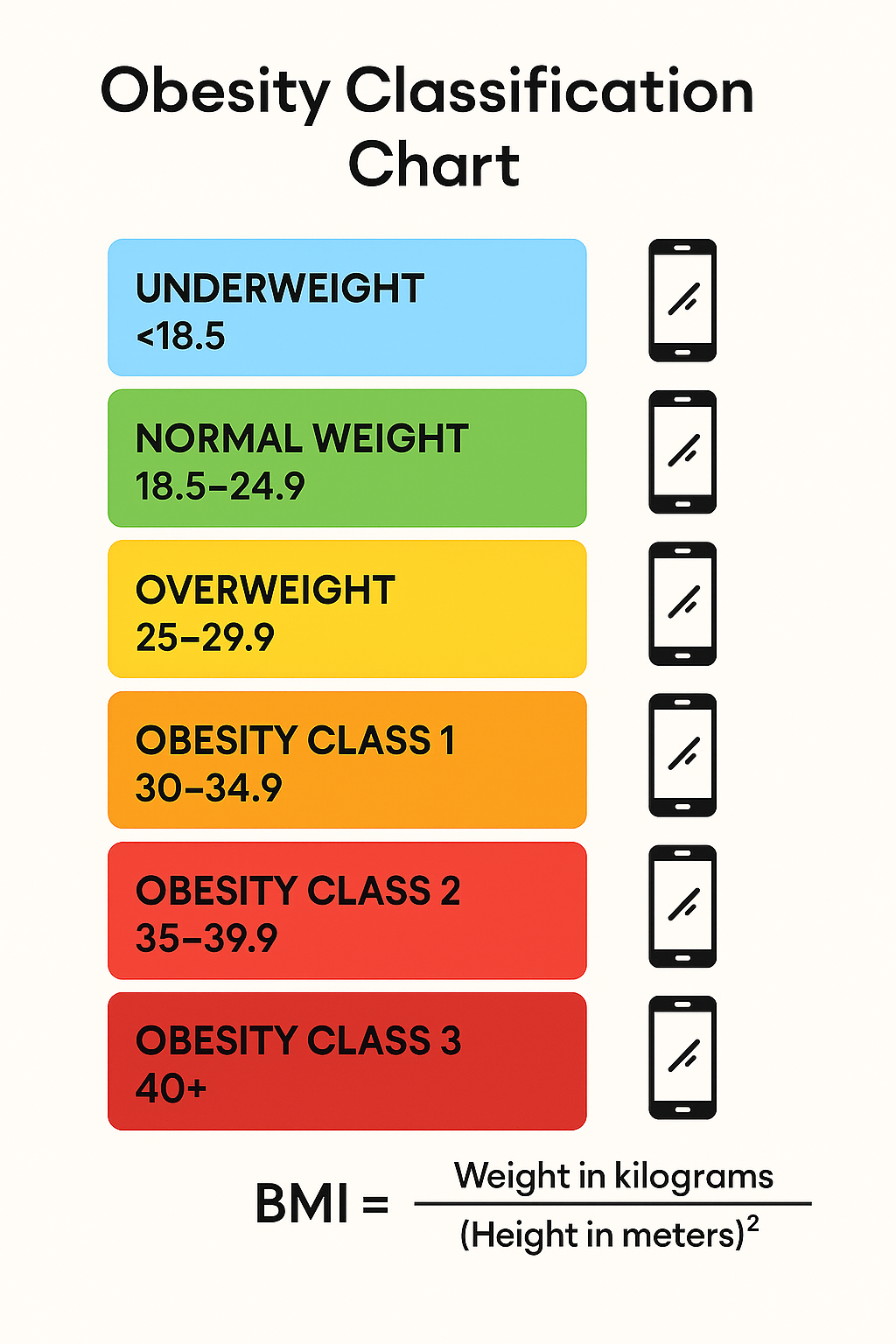Key Takeaways:
- Obesity is Multi-Factorial: It’s not just about personal willpower—environment, access, and policy play major roles.
- Food Availability Matters: Limited access to fresh, nutritious foods—especially in food deserts—pushes people toward ultra-processed alternatives.
- Government Policy Shapes Diets: Agricultural subsidies, marketing regulations, and school lunch programs can either fight or fuel obesity.
- Geography Influences Lifestyle: Urban planning that favors cars over walking, and limited green spaces, discourages physical activity.
- Micro-Environment Counts: Household habits, cultural food norms, and work-life stress levels significantly influence dietary choices and health behaviors.
- Macro-Environment Is Crucial: Global food corporations, media marketing, and economic inequality set the stage for unhealthy population-wide trends.
- Stress and Economic Pressure: Chronic stress from financial insecurity or unstable jobs often leads to emotional eating and poor health outcomes.
- Health Disparities Are Real: Lower-income and marginalized communities bear a disproportionate burden of obesity due to systemic barriers.
Obesity is often framed as a matter of personal choice—eat less, move more, and you’ll lose weight. But reality is far more complex. The causes of obesity are deeply rooted in our environments, systems, and structures that go far beyond individual behavior. From government policies to geography, the odds are often stacked against people trying to maintain a healthy weight.
Let’s unpack the key factors that influence why obesity has become a global epidemic.
1. Availability and Access to Fresh Foods
Not everyone has equal access to healthy, fresh foods.
- Food Deserts: In many urban and rural areas, grocery stores with fresh produce are hard to find. Residents rely on convenience stores or fast-food chains stocked with ultra-processed, high-calorie foods.
- Cost Factor: Even when fresh food is available, it’s often more expensive than calorie-dense junk food. A McDonald’s meal can cost less than a basket of vegetables.
- Shelf Life & Convenience: Processed foods last longer and are easier to store, making them more attractive for low-income families or those without refrigerators.
📍 Example: A 2023 USDA report found that low-income neighborhoods in the U.S. had 50% fewer supermarkets per capita compared to wealthy neighborhoods.
2. Government Policies and Food Industry Influence
Government policy directly impacts what people eat.
- Agricultural Subsidies: Many governments heavily subsidize crops like corn, soy, and wheat—core ingredients in processed foods. Fresh fruits and vegetables often receive little to no support.
- Lax Regulations on Food Marketing: In many countries, junk food companies are allowed to advertise directly to children. Cartoon characters, celebrity endorsements, and mobile games all promote unhealthy snacks.
- School Lunch Programs: In some regions, public schools serve high-sodium, low-nutrient meals due to budget constraints or contracts with large food corporations.
📍 Example: Mexico implemented a soda tax in 2014 to curb obesity. Within a year, sugary drink sales dropped by 12%, showing how policy can shift public health.
3. Geography and Built Environment
Where you live plays a significant role in how you eat and move.
- Urban Planning: Suburban sprawl often limits walkability. Without sidewalks, bike lanes, or nearby parks, physical activity becomes an extra chore.
- Rural Isolation: People in rural areas may have to travel miles to access a gym or buy fresh produce, making them more dependent on shelf-stable, processed goods.
- Climate and Seasonality: Cold or rainy climates discourage outdoor activity, and seasonal access to fresh foods is limited in many areas.
📍 Example: A 2022 WHO report showed that urban children in car-centric cities like Houston or Riyadh had 30% lower physical activity levels compared to kids in more walkable cities like Amsterdam or Tokyo.
4. Micro and Macro Environments
The environments closest to us—homes, schools, offices—as well as societal norms, shape health outcomes.
Micro-Level Factors:
- Family Habits: Children mimic parental behaviors. If meals are mostly takeout and sedentary time is the norm, obesity risk increases.
- Work Schedules: People working long shifts or multiple jobs often lack time to cook or exercise.
- Cultural Norms: In some communities, large portions or high-calorie celebrations are normalized.
Macro-Level Factors:
- Cultural Food Systems: Globalization and fast-food chains have displaced traditional diets. Meals rich in grains, legumes, and vegetables are replaced by fries and soda.
- Media & Advertising: Social media pushes unhealthy beauty standards and promotes “quick fixes” like diet pills or detox teas instead of balanced nutrition.
📍 Example: Studies show that in households where family dinners happen at least 5 times a week, obesity rates in children drop significantly.
5. Biological and Genetic Factors
Not everyone’s body responds to food and exercise the same way.
- Genetics: Some people are predisposed to gain weight more easily due to inherited metabolic factors.
- Hormonal Imbalances: Conditions like hypothyroidism or PCOS can increase obesity risk.
- Microbiome: The gut flora—shaped by early diet, antibiotics, and environment—can influence how calories are processed.
📍 Example: A study in Nature (2020) showed that identical twins eating the same foods had drastically different blood sugar responses, largely due to gut microbiota.
6. Psychological and Social Stressors
Chronic stress and mental health struggles also play a critical role.
- Stress Eating: Cortisol, the stress hormone, increases appetite and fat storage.
- Sleep Deprivation: Poor sleep disrupts hunger hormones like ghrelin and leptin, leading to overeating.
- Social Isolation: Loneliness and depression often trigger comfort eating, especially of sugary or fatty foods.
📍 Example: During the COVID-19 pandemic, global obesity rates spiked as people faced isolation, stress, and limited mobility.
7. Economic Inequality and Class Dynamics
Poverty is one of the strongest predictors of obesity.
- Inexpensive Calories: High-fat, high-sugar foods offer more calories per dollar than healthy alternatives.
- Limited Healthcare Access: Preventative care and nutrition counseling are luxuries for many.
- Corporate Influence: Large food companies target economically vulnerable groups with cheap, accessible, addictive foods.
📍 Example: In the U.S., obesity rates are highest among adults earning less than $25,000/year.
Final Thoughts: Obesity Is a Systemic Issue, Not a Personal Failure
Obesity is not simply about willpower. It’s the result of a deeply unequal and profit-driven global system that prioritizes convenience, consumption, and short-term gains over long-term health.
Solving the obesity crisis requires structural changes: better urban planning, equitable food access, strict food regulations, healthcare access, and cultural shifts in how we think about health and body size.
Until these systemic drivers are addressed, telling people to “just eat better” will continue to miss the mark.



